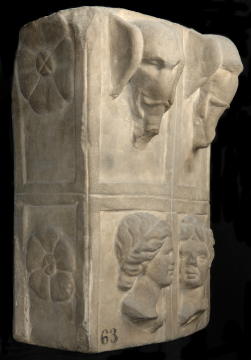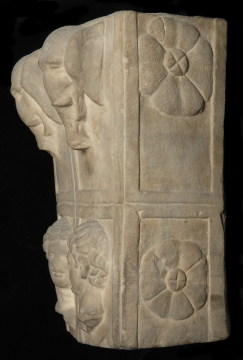Explore Collections


You are here:
CollectionsOnline
/
Section of a statue of the Artemis Ephesia (also sometimes called the Ephesian Artemis / Ephesian Diana)
Browse
Section of a statue of the Artemis Ephesia (also sometimes called the Ephesian Artemis / Ephesian Diana)
Pentelic marble
Height: 29cm, maximum
Width: 19.5cm
Thickness (excluding restoration): 12cm
Width: 19.5cm
Thickness (excluding restoration): 12cm
Museum number: M63
On display: Museum Corridor - outside the Picture Room
All spaces are in No. 13 Lincoln's Inn Fields unless identified as in No. 12, Soane's first house.
For tours https://www.soane.org/your-visit
Curatorial note
A section of the lower torso of a variation of the Artemis Ephesia statue, consisting of the two paired protomai divisions immediately above the feet. Above, in flat rectangular frame mouldings, are the high relief heads of two African elephants with their trunks curled upwards to the right. Below, is a female bust with hair parted at forehead and in rolled plaints over the ear(s), facing right, opposite a male bust with hair in matted locks combed over the forehead, facing left, both in similar frames. On the sides, framed in the same way above and below, are four six-petaled rosettes.
The identification of this piece presents a problem, for although it appears to be the trunk of a cult statue of the Artemis Ephesia type, there are no well- known types of this figure with which it might be associated. However, there is a statue in the Villa Albani1 which was drawn in Clarac2 and which is discussed but not illustrated by Thiersch3. This statue has protomai of elephants heads and busts in identical arrangements as on the Soane fragment. Thiersch noticed that the Albani statue, which is located high up in the pediment of the left portico of the garden front of the Villa and therefore extremely difficult to examine, appears to be from a distance only a decorative work of dubious antiquity and at best heavily restored with the repair lines still showing. In size the Albani statue corresponds exactly with that from which the Soane section could have come, and there is a pronounced, horizontal division above and below the sections which match this fragment. The feet are perhaps ancient; above, probably only the torso to the neck and excluding the hands, the left of which holds modern metal staff. The protomai consist, as far as can be seen from below, of ox heads, flowers, bees, Grecian sphinxes, elephants, and the two busts in paired descending order, with single rosettes on the sides. Alinari Archive photo no.27787 shows the general locale and 27804 shows the statue to the feet; in the second photograph it can be seen that the section corresponding to the Soane piece has weathered completely differently, as have many of the breasts. This indicates that they are restorations in a slightly different marble. Since the Soane fragment is both antique and corresponds exactly to the lower sections of the Albani statue - the sections which are separated from the rest, the latter may have been restored from the Soane fragment, which may belong, or both may depend upon a type the other copies of which are no longer accessible. Perhaps the restorer was able to sell the lower fragment separately because of its bizarre appearance, and therefore replaced it with a copy in the already heavily restored antique. The peg holes and squared surfacing top and bottom would indicate that the statue from which the Soane fragment derived was made in several separate sections and joined along the mouldings between the sculptured panels; the similar joining at precisely the same places in the restored section corresponding to this in the Albani statue is at the worst a very startling coincidence. Considering the lengths to which the later Eighteenth Century restorers went in the commercial exploitation of their merchandise, it is not unlikely that the Soane section actually belongs to the Villa Albani-Torlonia Artemis Ephesia.
There is a good parallel for the elephants' heads in Roman Imperial decorative-furniture sculpture, and it is perhaps from here that they found their way onto this rare Roman variation of the Ephesian Diana. Identical African elephants' heads with curled trunks appear on two bench supports under a "Chariot Race of Cupids" sarcophagus at the immediate right in the Salle Della Biga of the Vatican (no.2365, German Archaeological Institute Neg. no, 39.779; sarcoph. No. (609) 2364). On this sarcophags the elephant head on the left, chipped and weathered, is clearly ancient, that on the right a restoration based on it.
Ephesos (Ephesus) itself has proven the source for at least three, varying statues of the Artemis Ephesia in recent decades.4 Greek imperial coins demonstrate, however, that other cities of Asia Minor also featured statues of goddesses based on the famous image at Ephesos.5
1 Sir John Beazley and Professor Bernard Ashmole drew this to the attention of Cornelius Vermeule, the writer of this catalogue entry, in the 1950s.
2 Reinach, RS, I, p.299, no.5.
3 Artemis Ephesia, p.35, no.25.
4 See E. Akurgal, Ancient Civilisations and Ruins of Turkey, Istanbul, 1969, p.146, pl.58.
5 See M. Comstock and C. Vermeule, Museum of Fine Arts [Boston] Bronzes, under no.95.
The identification of this piece presents a problem, for although it appears to be the trunk of a cult statue of the Artemis Ephesia type, there are no well- known types of this figure with which it might be associated. However, there is a statue in the Villa Albani1 which was drawn in Clarac2 and which is discussed but not illustrated by Thiersch3. This statue has protomai of elephants heads and busts in identical arrangements as on the Soane fragment. Thiersch noticed that the Albani statue, which is located high up in the pediment of the left portico of the garden front of the Villa and therefore extremely difficult to examine, appears to be from a distance only a decorative work of dubious antiquity and at best heavily restored with the repair lines still showing. In size the Albani statue corresponds exactly with that from which the Soane section could have come, and there is a pronounced, horizontal division above and below the sections which match this fragment. The feet are perhaps ancient; above, probably only the torso to the neck and excluding the hands, the left of which holds modern metal staff. The protomai consist, as far as can be seen from below, of ox heads, flowers, bees, Grecian sphinxes, elephants, and the two busts in paired descending order, with single rosettes on the sides. Alinari Archive photo no.27787 shows the general locale and 27804 shows the statue to the feet; in the second photograph it can be seen that the section corresponding to the Soane piece has weathered completely differently, as have many of the breasts. This indicates that they are restorations in a slightly different marble. Since the Soane fragment is both antique and corresponds exactly to the lower sections of the Albani statue - the sections which are separated from the rest, the latter may have been restored from the Soane fragment, which may belong, or both may depend upon a type the other copies of which are no longer accessible. Perhaps the restorer was able to sell the lower fragment separately because of its bizarre appearance, and therefore replaced it with a copy in the already heavily restored antique. The peg holes and squared surfacing top and bottom would indicate that the statue from which the Soane fragment derived was made in several separate sections and joined along the mouldings between the sculptured panels; the similar joining at precisely the same places in the restored section corresponding to this in the Albani statue is at the worst a very startling coincidence. Considering the lengths to which the later Eighteenth Century restorers went in the commercial exploitation of their merchandise, it is not unlikely that the Soane section actually belongs to the Villa Albani-Torlonia Artemis Ephesia.
There is a good parallel for the elephants' heads in Roman Imperial decorative-furniture sculpture, and it is perhaps from here that they found their way onto this rare Roman variation of the Ephesian Diana. Identical African elephants' heads with curled trunks appear on two bench supports under a "Chariot Race of Cupids" sarcophagus at the immediate right in the Salle Della Biga of the Vatican (no.2365, German Archaeological Institute Neg. no, 39.779; sarcoph. No. (609) 2364). On this sarcophags the elephant head on the left, chipped and weathered, is clearly ancient, that on the right a restoration based on it.
Ephesos (Ephesus) itself has proven the source for at least three, varying statues of the Artemis Ephesia in recent decades.4 Greek imperial coins demonstrate, however, that other cities of Asia Minor also featured statues of goddesses based on the famous image at Ephesos.5
1 Sir John Beazley and Professor Bernard Ashmole drew this to the attention of Cornelius Vermeule, the writer of this catalogue entry, in the 1950s.
2 Reinach, RS, I, p.299, no.5.
3 Artemis Ephesia, p.35, no.25.
4 See E. Akurgal, Ancient Civilisations and Ruins of Turkey, Istanbul, 1969, p.146, pl.58.
5 See M. Comstock and C. Vermeule, Museum of Fine Arts [Boston] Bronzes, under no.95.
Rome (see Curatorial note for evidence that this piece may have been part of a statue still in situ at the Villa Albani).
Literature
Description, 1930, p.41, fig. 18 (right centre).
Soane collections online is being continually updated. If you wish to find out more or if you have any further information about this object please contact us: worksofart@soane.org.uk





